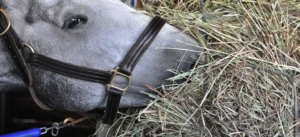 Determining Hay Quality for Horses: Hay quality is assessed primarily through on smell, feel, and visual appearance. Generally, hay should be fine-stemmed, green, and leafy. It should have a sweet smell and be free of any mold. Excessively bleached or discolored hay should be avoided. In addition, any that smells musty, dusty, or fermented. Avoid hay with high amounts of weeds, dirt, trash, or debris. In addition, hay with signs of insect infestation.
Determining Hay Quality for Horses: Hay quality is assessed primarily through on smell, feel, and visual appearance. Generally, hay should be fine-stemmed, green, and leafy. It should have a sweet smell and be free of any mold. Excessively bleached or discolored hay should be avoided. In addition, any that smells musty, dusty, or fermented. Avoid hay with high amounts of weeds, dirt, trash, or debris. In addition, hay with signs of insect infestation.
The presence of seed heads, stem coarseness, and a low leaf-to-stem ratio determine hay maturity. An abundance of leaves generally indicates higher nutrient levels in the hay. However, it is also important that leaves remain intact and do not fall from the stems too easily.
Palatability and the performance of horses being fed the hay somewhat judge quality. However, the ultimate test of quality is laboratory analysis. Kentucky Equine Research (KER) uses the forage laboratory at Dairy One Laboratories in New York for hay testing. International locations accept samples for analysis.
Hay to Feed:
As to what is the best type of hay to feed, there is no simple answer as it depends on what type of horse you have and what nutrients need to be supplied by forage. What is best for a foal or racehorse won’t suit a roly-poly pony, for example. Select hay according to the needs of the particular class of horses such as foals, pregnant mares, competition horses, horses recovering from illness, and so on.
Legume Hays:
Hays like lucerne (alfalfa) and clover have higher levels of energy, protein, and calcium than plain grass hays. Horses with higher requirements for protein and calcium such as growing or breeding horses would benefit from lucerne in their diets, as well as some hard-working performance horses. Endurance horses need diets without excessive protein or calcium, so high energy grass hay such as Teff are ideal. Obese horses usually need low-energy hay, so mature grass hays are best. Any horses with metabolic problems or digestive issues would also benefit from hays that contain lower levels of sugars, and grass hays are ideal for these situations.
Baled Hay:
Hay baled at a high moisture level or hay that has gotten wet in storage may be moldy. Moldy hay will smell musty. It will look damp and dull in color. It may even have patches of white or brown mold that makes the hay clump together. Generally, moldy hay is less palatable for horses. Therefore, reduced intake is the first issue. Mold contains mycotoxins that can cause a number of illnesses including colic in horses. Moldy hay is also dustier than normal hay. This dust contains fungal spores. Horses can inhale. This can irritate the respiratory tract. The irritation can lead to diseases such as heaves or recurrent airway obstruction because the dust causes inflammation in the lungs, increasing respiratory effort and reducing exercise tolerance.
Do you have question about Determining Hay Quality for Horses? Contact us at J & J Hay Farms by clicking here!
Article Sources: Kentucky Equine Research
